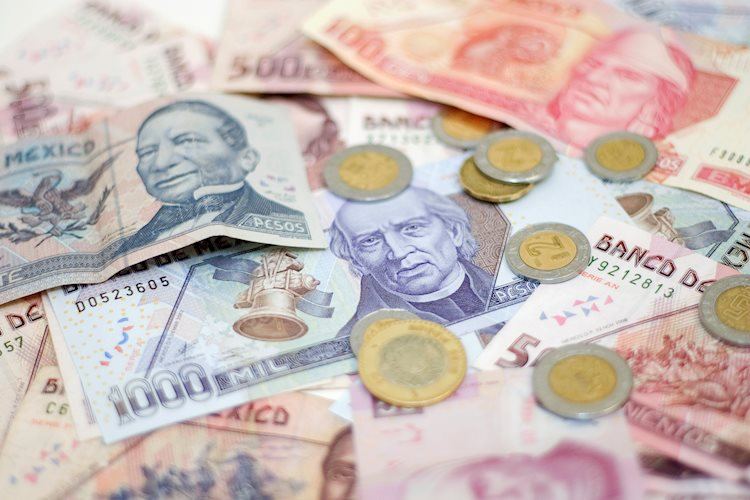- Mexican Peso extends its gains and is set to finish below the 18.12 mark.
- Mexico’s trade deficit widens, but Peso holds gains amidst flight to safety in markets.
- US inflation data justifies higher interest rates, but the market is skeptical of the Fed raising rates past the current range.
Mexican Peso (MXN) remains firm, posting decent gains vs. the US Dollar (USD) late in the North American session even though market sentiment shifted sour on Middle East conflict escalation, despite economic data from Mexico being worse than estimated. The latest inflation report from the United States (US), although it justifies higher interest rates, failed to underpin the USD/MXN, which is set to finish the week at 18.09, down 0.24%.
In the last couple of hours, the mood shifted as news headlines revealed Israel expanded its ground operations In Gaza, triggering a flight to safety, with Gold breaching the $2,000 mark. Meanwhile, the emerging market currency held to its gain even though Mexico revealed its Trade deficit widened in September from $-1.377 billion in August to $-1.481 billion. Across the border, the US Federal Reserve (Fed) preferred gauge for inflation, the Core Personal Consumption Expenditures (PCE) came at 3.7% YoY in September, below the consensus and August’s 3.8%.
Although figures remain almost twice the Fed’s 2% inflation target, market participants remain skeptical that the Fed will raise rates past the current 5.25% – 5.50% range, as demonstrated by the CME FedWatch Tool.
Daily Digest Market Movers: Mexican Peso revives, USD/MXN falls below 18.10
- Mexico’s September Trade balance printed a deficit of $-1.418 billion, worse than August’s and estimates of $-1.377 billion and $-0.71 billion, respectively.
- US PCE Index rose by 3.4% YoY, unchanged from August and aligned with estimates.
- US Core PCE annually based, cooled from August’s 3.8% to 3.7% in September, but came out as expected.
- US Q3 GDP grows at an annualized rate of 4.9%, higher than the 4.2% consensus.
- On October 24, Mexico’s National Statistics Agency INEGI reported annual headline inflation hit 4.27%, down from 4.45% at the end of September, below forecasts of 4.38%.
- Mexico’s core inflation rate YoY was 5.54%, beneath forecasts of 5.60%.
- Earlier this week, S&P Global Manufacturing PMIs evidenced expansion in US manufacturing and service sectors during October.
- The Bank of Mexico (Banxico) held rates at 11.25% in September and revised its inflation projections from 3.50% to 3.87% for 2024, above the central bank’s 3.00% target (plus or minus 1%).
Technical Analysis: Mexican Peso climbs as USD/MXN remains above the 20-day SMA at around 18.09
The USD/MXN uptrend remains intact despite Friday’s dip below the 18.00 figure, which puts the 20-day Simple Moving Average (SMA) at 18.08 at risk of being decisively broken to the downside. A daily close below the latter could pave the way for a fall below 18.00 and a test of the 200-day SMA at 17.72. On the flip side, if the exotic pair remains above the 20-day SMA, the next resistance will emerge at the October 26 high at 18.42 before challenging last week’s high at 18.46, ahead of challenging the 18.50 figure.
Risk sentiment FAQs
In the world of financial jargon the two widely used terms “risk-on” and “risk off” refer to the level of risk that investors are willing to stomach during the period referenced. In a “risk-on” market, investors are optimistic about the future and more willing to buy risky assets. In a “risk-off” market investors start to ‘play it safe’ because they are worried about the future, and therefore buy less risky assets that are more certain of bringing a return, even if it is relatively modest.
Typically, during periods of “risk-on”, stock markets will rise, most commodities – except Gold – will also gain in value, since they benefit from a positive growth outlook. The currencies of nations that are heavy commodity exporters strengthen because of increased demand, and Cryptocurrencies rise. In a “risk-off” market, Bonds go up – especially major government Bonds – Gold shines, and safe-haven currencies such as the Japanese Yen, Swiss Franc and US Dollar all benefit.
The Australian Dollar (AUD), the Canadian Dollar (CAD), the New Zealand Dollar (NZD) and minor FX like the Ruble (RUB) and the South African Rand (ZAR), all tend to rise in markets that are “risk-on”. This is because the economies of these currencies are heavily reliant on commodity exports for growth, and commodities tend to rise in price during risk-on periods. This is because investors foresee greater demand for raw materials in the future due to heightened economic activity.
The major currencies that tend to rise during periods of “risk-off” are the US Dollar (USD), the Japanese Yen (JPY) and the Swiss Franc (CHF). The US Dollar, because it is the world’s reserve currency, and because in times of crisis investors buy US government debt, which is seen as safe because the largest economy in the world is unlikely to default. The Yen, from increased demand for Japanese government bonds, because a high proportion are held by domestic investors who are unlikely to dump them – even in a crisis. The Swiss Franc, because strict Swiss banking laws offer investors enhanced capital protection.
